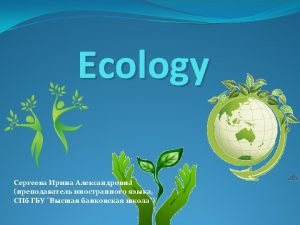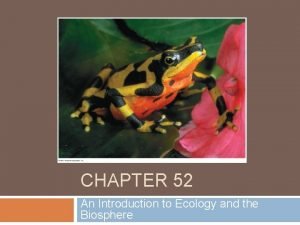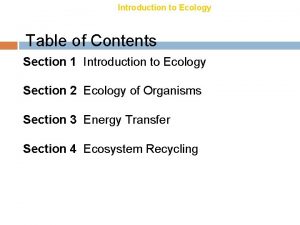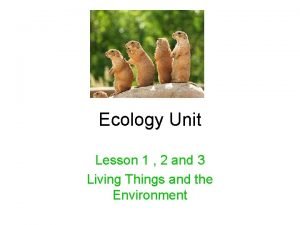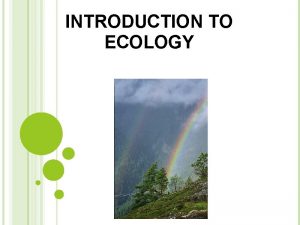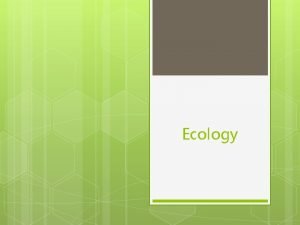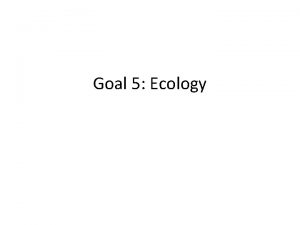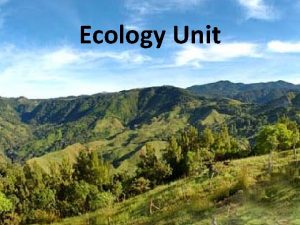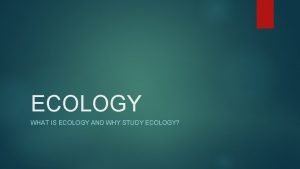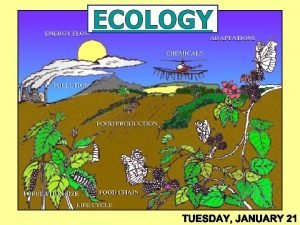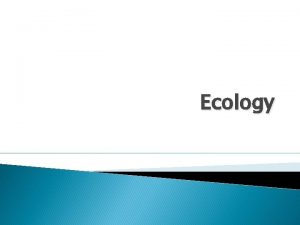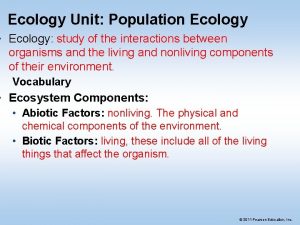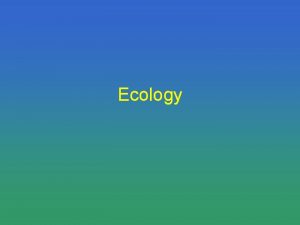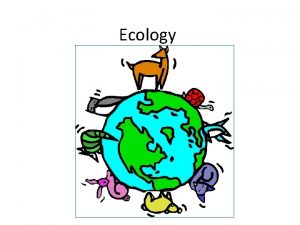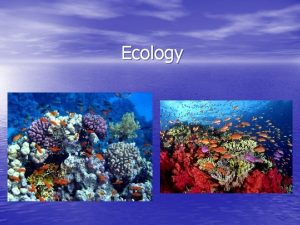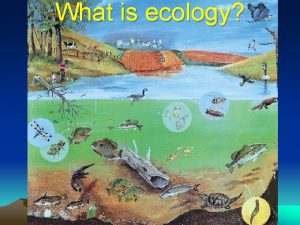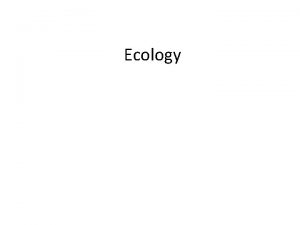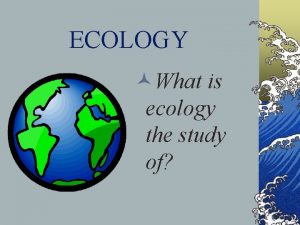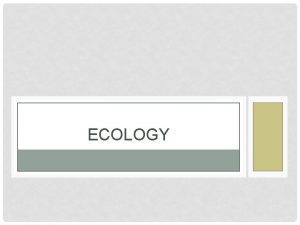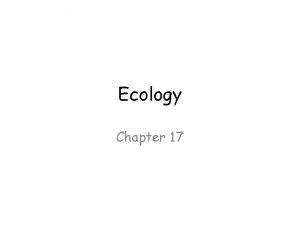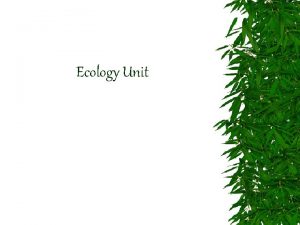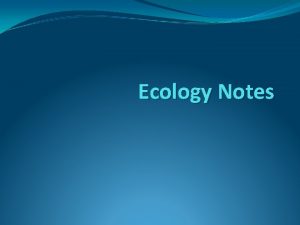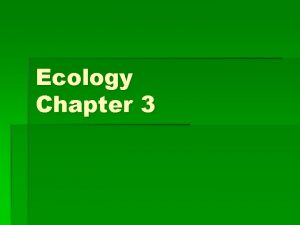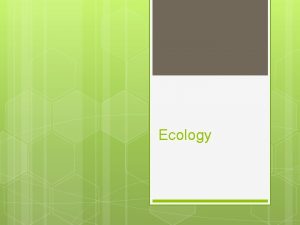Introduction to Ecology ECOLOGY The study of the




































- Slides: 36

Introduction to Ecology

ECOLOGY • The study of the interactions that take place among organisms and their environment

1. Organism – an individual living thing

2. Population All the organisms in an ecosystem that belong to the same species

3. Community All the populations in an ecosystem

4. Ecosystem All the organisms living in an area AND the nonliving features of their environment

organism population community ecosystem


Within An Ecosystem… • Habitat- provides shelter and resources so that animals can survive • Niche- the role of an organism in its ecosystem- how does it survive?

Producers & Consumers • Producer: makes its own energy through photosynthesis (aka autotroph) • Consumer: must consume other organisms to gain energy (aka heterotroph) • Energy is constantly being transferred between organisms and their environments!

Factors in an Ecosystem • Organisms depend on biotic and abiotic factors for survival – Biotic: living – Abiotic: nonliving • Biotic & abiotic factors influence what organisms can live in a certain area • *Limiting Factor- any resource that limits how large a population can grow

Find as many biotic and abiotic factors as you can!

Community Interactions • Powerfully affect an ecosystem! • Include: – Competition – Predation – Symbiosis

Competition • Organisms attempt to use an ecological resource at the same place and the same time – Resource anything necessary to survive • Food, water, space, mate, shelter, oxygen, sunlight, etc – Plants and animals compete – Winner and losers

Predation • Interaction where a consumer captures and feeds on another consumer • Predator (consumer) – Organism that does the killing and eating • Prey (consumer) – Organism that is being killed and eaten (victim)






Symbiosis • Any close relationship between two species • Symbiosis literally means “living together” • 3 types: – Mutualism (+/+) – Commensalism (+/0) – Parasitism (+/-)

Mutualism • Both species benefit from the relationship • A Happy couple • (+/+)

Mutualism • How do both species benefit?

• Who is helping who?

Ants and Aphids • Aphids provide honeydew to the ants, while the ants will take the aphids into their nests at night to protect them from predators and escort them back to a plant the next morning. • The ants collect the aphid's eggs and place them in their nests to survive the cold winter months!


Commensalism • One member of the relationship benefits while the other is neither harmed nor helped • One-sided (+/0) • Usually for food or shelter



Parasitism • One organism lives on or inside another organism and harms it (+/-) • Parasite obtains all or part of its nutrients from the other organism • Host – Organism that is harmed in relationship; the one that provides the nutrients to the parasite • Parasite – Organism that gets its nutrients from the host • Do they want to kill their host? – No, because they need them…they will weaken or hurt the host in some way





Can You Answer These? • What is Ecology? Study of interactions between organisms & environment • What are 3 relationships in ecosystems? Competition, Predator-Prey, Symbiosis • What are 3 types of symbiosis? Mutualism, Commensalism, Parasitism • What is the difference between an ECOSYSTEM and a BIOME? Ecosystem- all living & nonliving factors of an environment; Biome- large geog. area w/similar climate & organisms

Tonight’s HW • 49 L- “Two For One Deal”: • WORK INDEPENDENTLY! • Read and highlight (new/important ideas) • Then, answer questions on the 3 rd page. • In the “WHY” column, you must explain how each is benefiting and/or harmed/not affected.
 Ecology study guide
Ecology study guide Chapter 3, section 1: community ecology answer key
Chapter 3, section 1: community ecology answer key Ecology is the study that helps to preserve
Ecology is the study that helps to preserve Marine ecology
Marine ecology Chapter 52 an introduction to ecology and the biosphere
Chapter 52 an introduction to ecology and the biosphere Section 18-1 introduction to ecology worksheet answers
Section 18-1 introduction to ecology worksheet answers Lesson 1: introduction to ecology answer key
Lesson 1: introduction to ecology answer key What is case series
What is case series Retrospective cohort study vs prospective cohort study
Retrospective cohort study vs prospective cohort study Work study and method study
Work study and method study Marty lobdell
Marty lobdell Phytogeographical regions of india
Phytogeographical regions of india Work study objectives
Work study objectives Differentiate between time study and motion study
Differentiate between time study and motion study Hình ảnh bộ gõ cơ thể búng tay
Hình ảnh bộ gõ cơ thể búng tay Bổ thể
Bổ thể Tỉ lệ cơ thể trẻ em
Tỉ lệ cơ thể trẻ em Chó sói
Chó sói Glasgow thang điểm
Glasgow thang điểm Alleluia hat len nguoi oi
Alleluia hat len nguoi oi Các môn thể thao bắt đầu bằng tiếng đua
Các môn thể thao bắt đầu bằng tiếng đua Thế nào là hệ số cao nhất
Thế nào là hệ số cao nhất Các châu lục và đại dương trên thế giới
Các châu lục và đại dương trên thế giới Cong thức tính động năng
Cong thức tính động năng Trời xanh đây là của chúng ta thể thơ
Trời xanh đây là của chúng ta thể thơ Mật thư anh em như thể tay chân
Mật thư anh em như thể tay chân Làm thế nào để 102-1=99
Làm thế nào để 102-1=99 độ dài liên kết
độ dài liên kết Các châu lục và đại dương trên thế giới
Các châu lục và đại dương trên thế giới Thể thơ truyền thống
Thể thơ truyền thống Quá trình desamine hóa có thể tạo ra
Quá trình desamine hóa có thể tạo ra Một số thể thơ truyền thống
Một số thể thơ truyền thống Cái miệng bé xinh thế chỉ nói điều hay thôi
Cái miệng bé xinh thế chỉ nói điều hay thôi Vẽ hình chiếu vuông góc của vật thể sau
Vẽ hình chiếu vuông góc của vật thể sau Biện pháp chống mỏi cơ
Biện pháp chống mỏi cơ đặc điểm cơ thể của người tối cổ
đặc điểm cơ thể của người tối cổ


